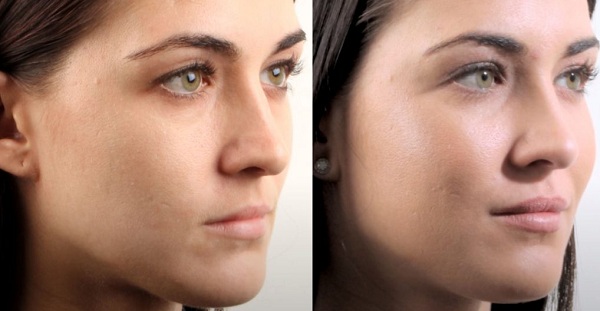Dermal Fillers
Dermal fillers are gel-like substances that are injected beneath the skin to restore lost volume, smooth lines and soften creases, or enhance facial contours. More than 1 million men and women annually have choose this popular facial rejuvenation treatment, which can be a cost-effective way to look younger without surgery or downtime.




Why it’s done
Dermal fillers help to diminish facial lines and restore volume and fullness in the face.
As we age, our faces naturally lose subcutaneous fat. The facial muscles are then working closer to the skin surface, so smile lines and crow’s feet become more apparent.
The facial skin also stretches a bit, adding to this loss of facial volume. Other factors that affect the facial skin include sun exposure, heredity and lifestyle.
What dermal fillers can do
- Plump thin lips
- Enhance shallow contours
- Soften facial creases and wrinkles
- Improve the appearance of recessed scars
- Reconstruct contour deformities in the face
- Decrease or remove the shadow of the lower lids
Dermal fillers can be very helpful in those with early signs of aging, or as a value-added part of facial rejuvenation surgery.
Questions? We got Answers!
While dermal fillers are casually known as “wrinkle fillers,” they can do much more than just smooth out wrinkles, although they are excellent at this too! Here are a few of the common issues dermal fillers can help address:
- Smooth out lines around nose and mouth (a.k.a. marionette lines, smile lines, and parentheses)
- Enhance & restore volume to sunken cheeks or temples
- Diminish vertical lip lines
- Plump & enhance the lips
- Smooth out a chin crease
- Improve symmetry among facial features
There are a variety of FDA approved filler products that cosmetic surgeons use. In general, fillers are categorized by the substance they are made from. A note for your safety: always make sure that you are receiving FDA approved, brand name fillers, which are only available through a licensed physician, such as a board certified cosmetic surgeon.
- Hyaluronic Acid (HA)
- Calcium Hydroxylapatite (CaHA)
- Poly-L-lactic Acid
- Polymethylmethacrylate (PMMA)
- Autologous fat injections (facial fat grafting)
Dermal filler injections are non-surgical and typically completed during an office visit. Your initial treatment will begin with a consultation, during which you will meet with your cosmetic surgeon to discuss your concerns and goals.
Pre-treatment consultation
During your consultation, cosmetic surgeon will evaluate your area of concern and review your medical history. While the risks associated with dermal fillers are minimal, you need to fully disclose your medical history prior to treatment, as certain allergies, skin and neurological conditions, or medications can jeopardize your safety or results. For instance, you need to tell your cosmetic surgeon if you have been taking NSAIDs (e.g., aspirin, ibuprofen, naproxen) or blood thinners, as these increase the likelihood of bruising.
Your injectable filler treatment
Just before the actual treatment, the area will be cleaned, and you may be given a topical anesthetic to numb the area prior to injection. Many filler products also contain lidocaine, a mild anesthetic, which is intended to help minimize discomfort during and after your treatment. Your provider will then inject a precise amount of filler strategically beneath the skin.
Depending on the product and the areas treated, you should be able to notice results immediately after receiving filler injections. Some patients experience mild bruising and swelling, but these are temporary and should subside over the days following treatment. You will be able to go back to your normal activities right after treatment, but your cosmetic surgeon may ask you to take the day off from exercise or other strenuous activity.
If you are having fat injections…
Facial fat grafting is a surgical procedure and follows a different treatment protocol. Typically, fat grafting is performed as an outpatient procedure, using general anesthesia or local anesthesia with sedation. Up to 2 weeks of downtime may be required, depending on the extent of liposuction performed. Your cosmetic surgeon will go over what to expect with surgery and recovery during your consultation.
How long the effects of dermal fillers will last depends on the product, the area of treatment, and the patient. Generally speaking, the denser the product is and the more deeply it is injected, the longer it will last, although this is not a hard and fast rule. To maintain your results, your cosmetic surgeon will simply repeat treatment, adjusting the amount and techniques as necessary to ensure optimal results.
Hyaluronic acid fillers tend to be the most temporary option, and therefore are often recommended for first-time filler patients. These will typically last from 6 to 18 months. Injections to the lips will wear out a little faster than those to the nasolabial folds. Certain HA fillers, such as VOLUMA, are formulated to last longer, but are usually limited to certain areas, such as the cheeks.
Synthetic fillers tend to last longer, as they are not absorbed by the body. They can be a great option for the right patient, but you’ll want to be ready to commit to results that will be there for several years—and choose an experienced, qualified provider whose aesthetic style you like.
Fat injections are meant to last indefinitely; however, some of the injected fat is expected not survive. Initially, your cosmetic surgeon may overfill the treatment area, resulting in an initially fuller look that will gradually settle into a more natural appearance.

